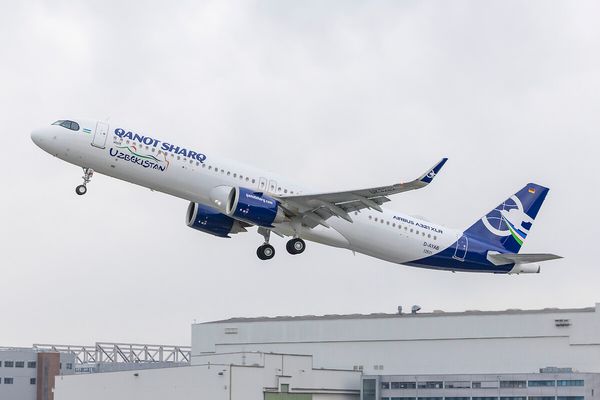Whether it's low-cost carriers or all business operators, it seems that no airline can survive in the land down under. Earlier this month, now defunct Bonza Airlines joined the almost 300 failed Australian airlines in the past 100 years.
Even major airlines like Ansett Australia and more recently Virgin Australia have collapsed, begging the question if all Australian airlines will eventually become pieces of history. Here's a look at five failed airlines and the impact they left on Australian aviation.

Compass

Before 1990, the Australian government heavily regulated the Australian aviation industry. Under the Two Airlines Policy, the Government of Australia restricted intercapital flights to only two airlines. However, after October 1990 when the Australian government deregulated the aviation market, Bryan Gray (the founder of East-West Airlines) decided to try again.
Founded as Australia's first-ever low-cost airline, Compass sought to drastically bring down ticket fares in the country. Competing head to head against Ansett and Australian (later merged with Qantas), the two airlines together ensured the doom of Compass.
At major Australian airports (Sydney, Melbourne, Perth, Brisbane, and Adelaide), Compass had to use gates at terminals owned and operated by Ansett and Australian. As a result, Compass was forced to park its aircraft at the furthest and most remote parts of airport terminals, creating inconveniences for passengers and crew. The Australian government, though it deregulated aviation, still supported the notion of a two-airline policy, creating regulatory difficulties for the start-up airline.
About a year after its initial launch, Compass' inevitable doom came crashing down. Competing with Ansett and Australian on their major routes, Compass believed that they would survive by bringing down prices enough to bring customers onto their planes from the legacy airlines.
However, both Ansett and Australian lowered ticket prices to match Compass on all their routes, a revenue hit that the large airlines could take but Compass could not. Soon enough, on December 20, 1991, Compass halted all operations.
Ansett

Founded in 1935 by Reginald "Reg" Ansett, Ansett Australia was at one point Australia's largest domestic carrier. Operating a fleet of Airbus A320s, Boeing 737s, 747s, and 767s, Ansett had a fleet of over 100 aircraft at its peak.
One of the two airlines included the Australian governments Two Airlines policy, Ansett experienced a huge amount of growth in the latter half of the 20th century. With the deregulation of the airline industry in Australia, Ansett moved to international expansion in 1993, with service to Osaka, Hong Kong, Jakarta, and Shanghai aboard their Boeing 747 aircraft.
The beginning of the end for Ansett came with the purchase of 50% of Ansett by Air New Zealand in 1995. Through the end of the decade, Ansett encountered astronomical amounts of debt, reaching $1.3 million by the time it collapsed.
Part of the reason for their debt was the decrease in profits as a result of competition from low-cost carriers. This, combined with an expensive bid to become the official carrier for the 2000 Sydney Olympics, eventually led to the airlines demise. The tremendous decrease in passenger travel after September 11th was the final blow to Ansett. In late September 2001, Ansett's creditors placed the airline into administration, leading to the end of the carrier.
Tigerair Australia

Like Compass, Tigerair Australia sought to drastically reduce prices in the Australian aviation market. Beginning operations in November of 2007 with an Airbus A320 aircraft, Tigerair broke into highly competitive markets, like Sydney to Melbourne, and competed against the major airlines.
Tigerair operated on a business model reminiscent of ultra-low-cost carriers today such as Ryanair or EasyJet. The airline charged passengers for everything besides the ticket price from seat selection to meals to checked bags. Tigerair believed that their low starting prices would draw in price-minded consumers.
The airline grew significantly in the 2010s, expanding its existing base in Melbourne and adding additional bases in cities such as Sydney. However, the first signs of financial woes were evident in 2013 and 2014, when Virgin Atlantic became the majority shareholder in the airline and then took over the company
By February 2020, Virgin had downsized Tigerair's operations from 13 aircraft to just eight, suspending five routes and closing their Brisbane base. Then, with the onset of the Covid-19 pandemic, Virgin decided to suspend their long haul operations through Tigerair, effectively killing the 13-year-old airline.
OzJet

Unlike Tigerair, OzJet promoted itself as a premium airline. Beginning in 2005 on the same Melbourne to Sydney route that Tigerair flew, OzJet flew the Boeing 737-200 with just 60 seats in an all-business class configuration. For comparison, the most densely packed 737-200s at the time had close to 215 seats - over three times the number OzJet's aircraft had.
However, like many other start-up airlines in Australia, OzJet failed after only four months of operations. The airline sold seats for the same price as economy tickets on Virgin Australia and Qantas, but was not able to carve out a sizable market share to justify continuing operations.
Bonza

The most recent Australian airline to bite the dust is Bonza Airlines. In operation for less than 18 months, Bonza was launched in 2023 by former Virgin Blue executive Tim Jordan. Utilizing Boeing 737 MAX aircraft, Bonza mainly operated routes from its Sunshine Coast base to regional destinations across Australia.
However, the decision to use more expensive jet aircraft instead of cheaper turboprops like competitor Rex Airlines meant Bonza had to fill nearly all of their seats to turn a profit.
As the failure of the airline suggests, Bonza was not able to fill enough seats on their planes.
Attempting to differentiate itself from other defunct Australian airlines, Bonza worked off a plan of serving regional airports that the large Australian airlines did not service. However, they were constantly battling Virgin Australia and Qantas for slots at larger airports and faced many operational problems, such as luggage delays, flight cancellations, and communication issues. The airline did periods of growth, but they did not last for long. By July 2023, Bonza was already canceling routes and reducing frequencies.
As the past 100 years of Australian aviation have shown, starting a new airline down under is incredibly difficult.
Whether it was the Australian government's Two Airlines policy that encouraged the duopoly of Ansett and Trans Australia Airlines, or unpredictable events such as the COVID-19 pandemic, few airlines have been able to break through and successfully operate in Australia's aviation environment.
After the collapse of Bonza, it remains to be seen if any new airlines will be able to successfully operate flights compete with the two behemoths of Qantas and Virgin Australia in Australia.
JetBlue Opens First-Ever ‘BlueHouse’ Lounge at JFK Terminal 5 » Should Students Have Homework? Better After-School Balance » U.S. Government Admits Liability in Fatal Mid-Air Collision »
Comments (0)
Add Your Comment
SHARE
TAGS
INFORMATIONAL Ansett Virgin Australia Melbourne Sydney Perth Adelaide MEL SYD PER ADL Boeing Airbus Australia Bankrupt Failed Airlines AirlinesRECENTLY PUBLISHED
 Should Students Have Homework? Better After-School Balance
Is homework bad for students? Explore learning benefits, stress, sleep, and smarter workload limits, so after-school time stays balanced.
STORIES
READ MORE »
Should Students Have Homework? Better After-School Balance
Is homework bad for students? Explore learning benefits, stress, sleep, and smarter workload limits, so after-school time stays balanced.
STORIES
READ MORE »
 Air Canada Rouge to Launch Boeing 737 MAX 8 Operations
Air Canada has officially confirmed a strategic shift for its leisure subsidiary, Air Canada Rouge, announcing that Boeing 737-8 (MAX 8) operations are slated to begin in late Q1 2026. The move marks the beginning of an ambitious year-long transition that will see Rouge evolve into an all-Boeing 737 operator.
ROUTES
READ MORE »
Air Canada Rouge to Launch Boeing 737 MAX 8 Operations
Air Canada has officially confirmed a strategic shift for its leisure subsidiary, Air Canada Rouge, announcing that Boeing 737-8 (MAX 8) operations are slated to begin in late Q1 2026. The move marks the beginning of an ambitious year-long transition that will see Rouge evolve into an all-Boeing 737 operator.
ROUTES
READ MORE »
 Qanot Sharq Takes Delivery of First Airbus A321XLR to Transform Central Asian Long Haul Travel
Uzbekistan’s premier private carrier, Qanot Sharq, has officially taken delivery of its first Airbus A321XLR. The delivery, which took place today at the Airbus facility in Hamburg, makes Qanot Sharq the launch operator for the ultra-long-range narrow-body in the Commonwealth of Independent States (CIS) and Central Asia.
ROUTES
READ MORE »
Qanot Sharq Takes Delivery of First Airbus A321XLR to Transform Central Asian Long Haul Travel
Uzbekistan’s premier private carrier, Qanot Sharq, has officially taken delivery of its first Airbus A321XLR. The delivery, which took place today at the Airbus facility in Hamburg, makes Qanot Sharq the launch operator for the ultra-long-range narrow-body in the Commonwealth of Independent States (CIS) and Central Asia.
ROUTES
READ MORE »



